The Ocarina in The Legend of Zelda: Instrument of Depth


Intro
The ocarina stands as a prominent symbol in The Legend of Zelda series, yet its importance runs far deeper than simple gameplay mechanics. \ Since its introduction in Ocarina of Time, it has served multifaceted roles that not only enhance the narrative but also enrich the players' emotional connection with the game. It is crucial to understand that the ocarina is not just an instrument; rather, it is a bridge connecting the game's world to its players.
In this exploration, we will dissect the various layers of the ocarina's role across different iterations of The Legend of Zelda. From its historical underpinnings to its musical composition and cultural impact, every angle reveals something fresh and engaging. The ocarina becomes a tool for storytelling, a means of unlocking gameplay elements, and a vehicle for emotional resonance. We'll also dive into the memorable tunes that echo through the series, demonstrating how these compositions serve their function in gameplay while embedding themselves in the player's memory.
By meticulously analyzing how the ocarina affects the gameplay experience and its narrative significance, we aim to provide a comprehensive understanding that showcases the depth of this seemingly simple instrument. As we traverse through the various layers, it becomes apparent that the ocarina is an integral part of what makes The Legend of Zelda series a cherished staple in gaming history.
Prolusion to the Ocarina
The ocarina, a small wind instrument with a captivating sound, plays a pivotal role in the gaming landscape, particularly within The Legend of Zelda series. This section aims to establish a foundational understanding of the ocarina, diving into what it is and how it fits within the broader context of gameplay and narrative.
Its importance stretches far beyond just musical notes; the ocarina goes hand-in-hand with pivotal moments, emotional experiences, and essential gameplay mechanics. Not only does it bring an element of music into the fray, it also blurs the lines between the player’s interaction with virtual worlds and their own emotional reactions. The ocarina is more than just an instrument—it’s a narrative device that bridges gaps in storytelling, helping to engage players and immerse them within Link's journey.
Overview of the Ocarina
The ocarina is often depicted as a ceramic or clay wind instrument, which produces mellifluous melodies that resonate with players and characters alike. Shaped somewhat like an egg, this instrument has the unique ability to evoke emotions through its sound, harmonizing beautifully with the game’s sweeping landscapes and intricate plots.
The sound of the ocarina is distinct; its tones can be bright and cheerful or melancholic and reflective. Varied key combinations allow players to unlock different tunes, each carrying its own significance throughout the gameplay. From summoning helpful allies to altering the dynamics of time, the ocarina serves as a catalyst for many important narrative moments.
Historical Origins of the Ocarina
Historically, the ocarina's roots can be traced back to ancient cultures, where artists crafted these instruments out of materials like clay, bone, and wood. Originating in regions such as China, Central America, and parts of Europe, it holds a unique place in the world of traditional music. Understanding its historical journey lends depth to its role within the Zelda franchise.
Since its inception, the ocarina has been a vessel for cultural expression, often used in folklore and ceremonies. These associations resonate with its depiction in the Zelda series: a tool that carries history and meaning within its notes.
Though The Legend of Zelda: Ocarina of Time popularized its image, the ocarina represents a rich tapestry of global musical heritage. This intertwining of culture and gameplay invites players to not only engage with the game but to reflect on the music's broader implications in their own lives and society.
In bringing the ocarina into the realm of gaming, The Legend of Zelda taps into the timeless allure of music, settings, and stories that shape our experiences.
The Ocarina in The Legend of Zelda: Ocarina of Time
The Ocarina of Time stands as an iconic pillar in the vast landscape of The Legend of Zelda series. Its introduction in this particular iteration transformed not just gameplay mechanics but also the very narrative fabric of the game. Unlike many tools that players might encounter in video games, the ocarina connects the player's journey, emotions, and the unfolding story in a manner unparalleled in gaming history.
Gameplay Mechanics and Functions
Within Ocarina of Time, the ocarina functions more than just a musical instrument—it serves multiple key gameplay mechanics that significantly influence both exploration and combat. Players are introduced to the ocarina through a sequence that encapsulates its importance, creating an immediate understanding of its multifaceted usage.
The instrument operates through a series of notes, each corresponding to a specific button combination. This simple yet profound mechanic allows players to solve puzzles, manipulate the environment, and summon various characters. A telling example is the Song of Time, which permits Link to move massive blockages that impede his progression. The immediacy of the effects upon playing a song bridges the gap between exploration and problem-solving, making the game feel cohesive.
Moreover, the ocarina incorporates a time-travel narrative by allowing players to shift between Link’s childhood and adulthood, bringing a refreshing complexity to the plot. Manipulating time facilitates engaging puzzles and strategic gameplay in a world where tasks and quests evolve through different periods. This mechanic also adds layers to character interactions and developments, as friends and foes appear vastly different across timelines.
The integration of the ocarina also enriches the combat experience; certain melodies provide buffs or summon aid during challenging battles. Remembering the note patterns becomes a nostalgic touchstone for players as they strategize during intense encounters. The ocarina not only enhances gameplay but also creates growth opportunities for players, harnessing a sense of achievement when a song is played correctly.
Key Songs and Their Significance
The essence of Ocarina of Time's narrative lies deeply in the songs associated with the ocarina. Each melody woven into the story embodies thematic significance, echoing Link’s journey and his relationships within the game.
One of the notable songs is the Song of Healing. It not only serves its purpose of healing but also embodies emotional depth as it connects with various characters' backstories. The act of playing this song signifies Link’s role as not just a hero in battle but a figure of compassion who aids the tormented souls he encounters.
Another key piece, Zelda’s Lullaby, acts as a musical thread tying Link to Princess Zelda, symbolizing hope and protection. This lullaby reinforces her identity and reinforces the bond between them, making players more emotionally invested in their fates. The significance of this song enhances the narrative layer, providing a sense of nostalgia each time it resonates throughout Hyrule.
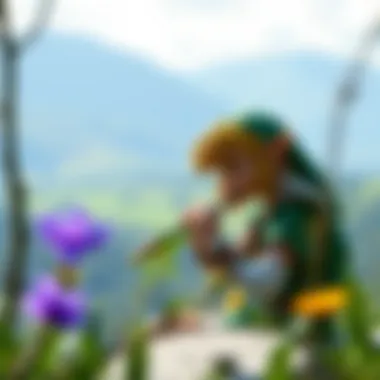
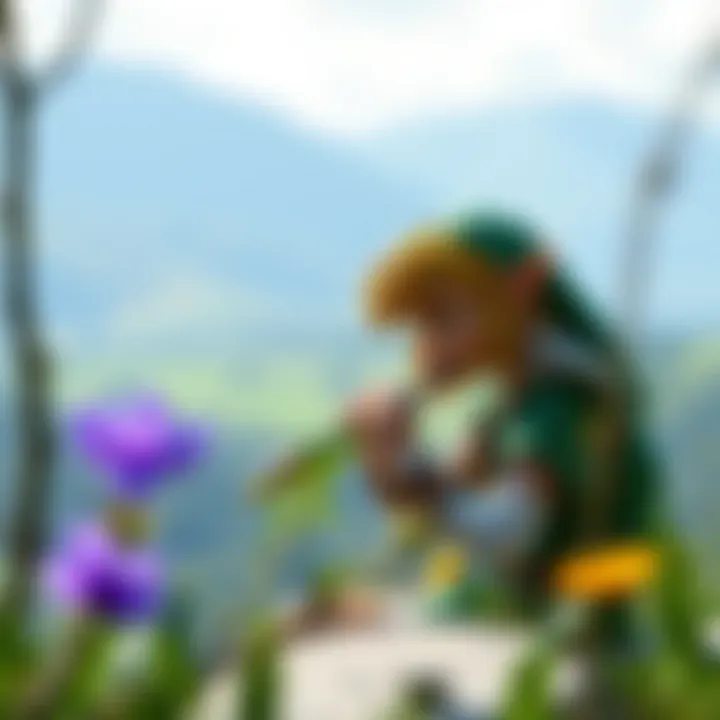
Additionally, players encounter the Song of Storms, which not only impacts the weather but showcases the clever intertwining of cause and effect within the plot’s timeline. Such songs do more than shift gameplay—they establish motives, drive emotional narratives, and contribute to character arcs, engaging players on a deeper scale.
"The Ocarina is not merely an object; it is a linchpin within the expansive tapestry of Hyrule's tales, empowering players to resonate with the game’s emotional landscape."
In essence, each song played serves dual purposes—affecting both gameplay and aiding in emotional storytelling. By intertwining musical themes with pivotal narrative moments, Ocarina of Time transforms the act of playing music into one of savior complex, allowing players to feel as if they are affecting the very world around them.
In summation, the ocarina within The Legend of Zelda: Ocarina of Time represents an emblem of connection. It's a gameplay tool, a narrative device, and an emotional anchor, melding together to create a rich gaming experience that transcends mere entertainment.
Musical Composition and its Role
In the landscape of The Legend of Zelda, the musical compositions that feature the ocarina play an instrumental role that goes beyond mere utility in gameplay. The melodies not only serve as a gameplay mechanic—allowing players to manipulate time, summon rain, or transport between locations—but they also enrich the narrative depth of the series. By intertwining music with thematic elements, the ocarina establishes a unique bridge between the gameplay experience and the story being told.
Analysis of Musical Themes
The melodies crafted for the ocarina are anything but arbitrary. They echo throughout the different installments of the Zelda franchise, each possessing a distinct identity that resonates with its respective game world. For instance, the haunting beauty of "Zelda's Lullaby" invokes feelings of serenity and hope, reflective of Princess Zelda's character and her deep connection to the kingdom of Hyrule. On the flip side, tunes like "Song of Storms," with its brisk tempo and lively notes, incite an air of whimsy that underpins the playful nature of the game.
A deeper look into these compositions reveals musical motifs that connect the gameplay to the overarching narrative. There is a consistent use of specific scales, intervals, and rhythms that aligns closely with the moods and themes prevalent in the story. Notably, the ocarina’s tunes evoke emotions through the choice of instruments, harmonization, and key changes, thus enhancing the immersion of the player.
"In the hands of a seasoned player, the ocarina becomes not just a tool, but a means for storytelling."
Also, the way these musical pieces are structured mirrors the gameplay mechanics. The repetition of certain motifs can signal impending changes or challenges—a signaling mechanism for the player to react promptly. This harmonious blend creates an intuitive experience whereby the players feel they are not only participants but also narrators of their own journey.
Emotional and Symbolic Impact
The emotionality of the ocarina's melodies carries significant weight. The music does not merely accompany the player; it draws them into the world of Zelda, making them part of its emotional fabric. Each song has the power to invoke nostalgia, resonate with loss, or inspire bravery. When players hear the gentle notes of the ocarina, they are often transported back to vivid moments in their gameplay when they faced overwhelming odds or discovered hidden secrets.
Moreover, the ocarina acts as a symbol within the series. It embodies themes of connection and legacy. In many instances, the melodies summon memories not just for Link, the protagonist, but also for players who have walked alongside him. The act of playing the ocarina can represent moments of reflection, with tunes designed to convey a message or spark an emotional response tied to the narrative arcs of various characters.
In a way, the compositions associated with the ocarina can be seen as a character unto itself—defining moments, shaping relationships between the protagonist and the world around him. Thus, the ocarina transcends its role as a musical instrument and becomes a vessel for storytelling, a means of expression, and a medium through which players can forge deep connections.
As players navigate the challenges, trials, and tribulations in The Legend of Zelda series, the music to which they play along reminds them not only of the journey they are on but also of the rich tapestry of experiences this journey entails.
Narrative Significance in the Series
In The Legend of Zelda series, the ocarina emerges as not just a mere tool for gameplay, but as a quintessential element that drives the emotional and thematic narrative forward. Its presence is felt deeply, affecting character interactions and shaping the player's overall journey through the games. This multifaceted instrument carries with it layers of meaning that go beyond surface-level mechanics, encapsulating the very essence of the story and spirit of the franchise.
Character Development Through Music
The ocarina serves as a vital medium for character development throughout various titles in the series. Link, the protagonist, is often seen interacting with the ocarina, not just as a gameplay mechanic but as a means of connecting with other characters and the game world itself. For instance, in Ocarina of Time, the relationship between Link and Princess Zelda is partly conveyed through shared musical experiences. Their connection grows stronger as they share songs that symbolize hope and friendship, illustrating the power of music to build relationships.
Moreover, individual characters experience growth and transformation through their interactions with music. Each melody played on the ocarina often resonates with the emotions of the character in that moment. The song for the Lost Woods, for example, not only allows Link to navigate a challenging environment but also reflects the disarray of those lost within it. These connections provide depth to characters who might otherwise seem one-dimensional, adding layers of richness to the narrative.
Connecting Plot and Gameplay
The integration of the ocarina into plot and gameplay creates a seamless experience that enhances player immersion. One of the most notable aspects is how music acts as a narrative device that allows players to unlock chapters of the story. In Majora's Mask, for instance, the ocarina allows players to manipulate time, directly tying gameplay mechanics into the overarching themes of fate and consequence. By using the instrument, players not only affect their immediate surroundings but also explore the very fabric of the game's timeline.
Furthermore, every song has its own lore and significance that relates back to the world-building of Hyrule. Players find themselves learning these songs, not just as tools for solving puzzles, but as means to unfold the ancient stories that permeate the landscape. For example, playing "Zelda's Lullaby" doesn't just summon a memory; it invokes the legacy of the royal family and the history that binds the characters together. This technique not only makes gameplay more engaging but also enriches the narrative, allowing the ocarina to function as a bridge between characters, plot, and the player.
In summary, the ocarina's role within the narratives of The Legend of Zelda series signifies how deeply intertwined music is with gameplay and character development. Through these connections, the instrument elevates the experience from mere play to something that resonates on an emotional and story-driven level. Whether it’s facilitating character growth or tying gameplay to plot progression, the ocarina remains a cornerstone of the series' storytelling.
Variations of the Ocarina in Subsequent Zelda Titles
The evolution of the ocarina throughout the Legend of Zelda series highlights its adaptability and significance in enhancing gameplay and narrative depth. Each iteration brings forth unique mechanics and cultural nuances that enrich the player’s experience. Understanding these variations allows enthusiasts to appreciate how this simple instrument evolves while still maintaining its core identity.
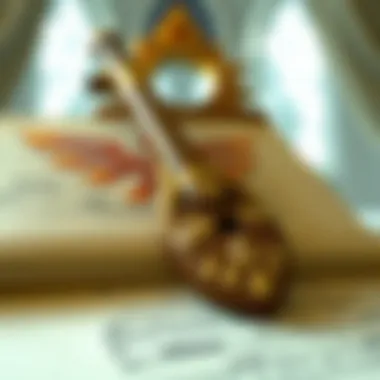

The Wind Waker and Beyond
In The Wind Waker, the ocarina metamorphoses into the Wind Waker baton, a more versatile tool that conducts wind rather than plays melodies. This change, while a departure from the traditional ocarina, serves a crucial role in gameplay. Players utilize the Wind Waker to shift the winds, allowing for shifts in sailing direction and exploring vast ocean expanses.
- Gameplay Mechanics:
- Strategic Navigation: Players must understand wind patterns to reach distant islands and unlock secret locations.
- Interactive Puzzles: The baton introduces various environmental puzzles, pushing players to experiment with music to manipulate resources.
Despite the shift in function, the essence of connection and choice remains. Many fans appreciate this evolution, noting that it retains the essence of what the ocarina represents. The leaps in gameplay afford a fresh dynamic, aligning with the game’s enchanting art style and storytelling methods.
Distinct Features Across Titles
As the Legend of Zelda series progressed, so did the ocarina's presence. Each game has its own flair while still tethered to the original.
- In Majora's Mask, it remains central, though its function is tied to time manipulation through songs, with the unique mechanic of the Song of Time being pivotal to gameplay. The ocarina supports the game’s darker theme while also enhancing moments of relief through music.
- Skyward Sword showcases another transformation, incorporating musical elements with the harp, which aligns perfectly with the celestial theme of the game. Here, the transition from ocarina to harp expands the nature of storytelling and gameplay, allowing players to imbue melodies with emotions and memories.
Each installment’s variation not only emphasizes the ocarina’s importance within gameplay but also reflects the growth of the franchise. From a navigational tool to an emotional expressor, the ocarina's ability to evolve while remaining intrinsically linked to the lore allows fans to forge a deeper connection with the gaming experience.
"The Ocarina is not just an instrument; it’s a bridge between the player and the world of Zelda, weaving through time and emotion in every note."
The adaptability found in the ocarina across various Zelda titles continues to resonate with fans and newcomers alike. This rich tradition showcases both the innovation inherent in the gaming industry and the timeless connection music has with storytelling.
Ultimately, these variations emphasize that the tool's significance transcends its mechanical use, making it an invaluable piece of the Legend of Zelda puzzle.
Cultural Resonance of the Ocarina
The cultural implications of the ocarina within the realm of The Legend of Zelda extend well beyond its gameplay contributions. It serves as a conduit through which players interact not only with the game’s world but also each other, cementing its role as a piece of cultural artefact. The ocarina encapsulates emotions, memories, and connections, transcending the typical boundaries of a mere in-game tool. In the vibrant fandom surrounding The Legend of Zelda, the ocarina resonates deeply, reflecting shared experiences and a collective nostalgia.
Influence on Other Media
The influence of the ocarina is palpable across various forms of media. From soundtracks in video games to orchestral performances, the melodies crafted around this instrument have inspired musicians, filmmakers, and artists alike. Various video games have taken cues from the ocarina’s unique ability to evoke emotion through melody. For instance, titles like Final Fantasy IX reference the use of instruments as critical gameplay mechanics, showcasing a similar thematic depth as found in Ocarina of Time.
Moreover, the ocarina’s appearance in popular culture has led to its inclusion in television shows and films, where it symbolizes nostalgia or the innocence of childhood. Animated series often depict characters playing ocarinas amidst adventures or quests, drawing a parallel to the quest-driven narratives of Zelda.
Examples of Influence:
- Film Scores: Composers like Joe Hisaishi have incorporated ocarina-like melodies in their orchestral pieces for Studio Ghibli films, elevating the emotional atmosphere.
- Popular TV Shows: Episodes of shows like Adventure Time feature scenes where characters utilize ocarinas, highlighting how their playful essence enriches storytelling.
- Music Covers: YouTube channels and music communities celebrate the ocarina as an instrument, producing covers of Zelda-themed songs, demonstrating its wide appeal across different audiences.
"The melodies that reverberate from an ocarina evoke sentiments steeped in both adventure and nostalgia, blending fantasy with reality in a way few instruments can."
Fandom and Real-Life Ocarina Renaissance
There’s a budding resurgence of interest in the ocarina, not just as a relic of gaming history but also as a beloved instrument among fans. This renaissance is characterized by the proliferation of online communities, where players share tips, tutorials, and resources for ocarina playing. Social media platforms and forums such as Reddit and Facebook become hotbeds for enthusiasts to come together, showcasing their skills or launching into friendly competitions.
- Online Communities: Dedicated groups on platforms like Reddit (e.g., r/ocarina) discuss techniques, instrument types, and styles of play. This community support fosters a deeper appreciation for the instrument and its use in gaming.
- DIY Ocarinas: The internet has enabled hobbyists to learn how to craft their own ocarinas, using various materials. Tutorials abound, leading to unique, personalized pieces that reflect the creativity of fans.
- Local Meetups and Events: Convention spaces often host ocarina workshops and meetups, allowing players to engage face-to-face, share techniques, and discuss their shared love of Zelda and music.
The ocarina has not only become a cherished object in the Zelda universe but also a symbol of connection in real life. Its melodic notes encapsulate memories of adventures undertaken in Hyrule, while also sparking new connections among players and musicians.
Gameplay Experiences and Community Engagement
In the landscape of gaming, the experience shapes not only how we interact with a game but also how we become part of its identity and community. The ocarina in The Legend of Zelda is not merely a tool for gameplay mechanics; it builds a bridge between the player and the narrative, creating shared experiences and fostering community spirit.
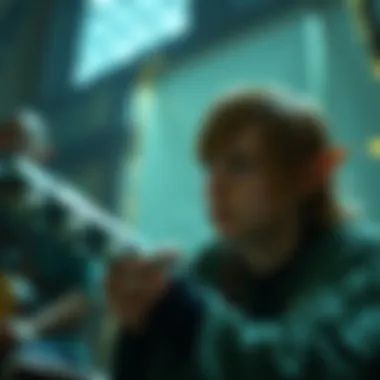
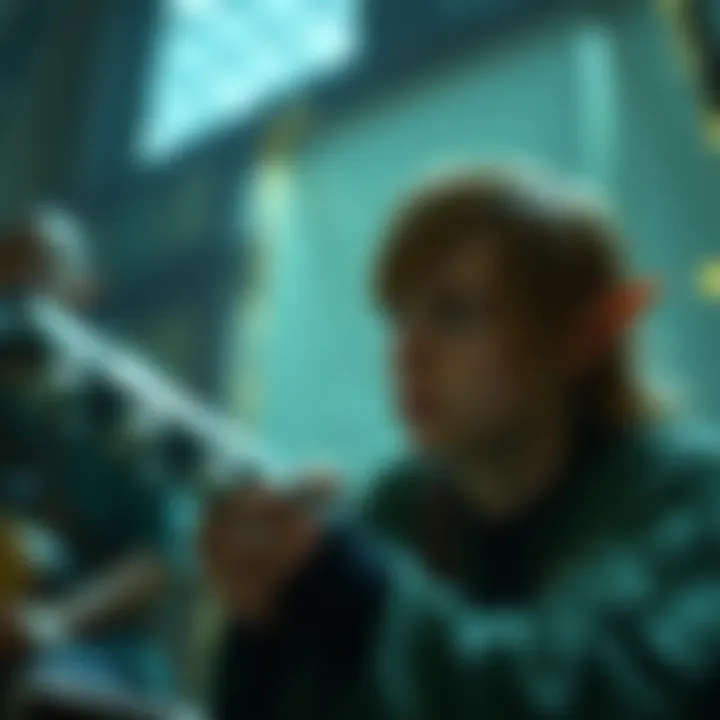
Player Interaction with the Ocarina
The ocarina offers players a unique way to engage with the world of Hyrule. Rather than being passive observers, players become active participants. This sense of agency is crucial; it turns gameplay into a personal journey rather than just a series of tasks to complete. Players manipulate the ocarina to solve puzzles, unlock hidden areas, and even influence the game’s ambient environment.
For example, in Ocarina of Time, each note played has significance beyond simple melodies. The songs serve to change day to night, summon rain, or even wake ancient beings trapped in slumber. This direct consequence of player interaction instills a sense of empowerment. In this way, the ocarina transforms the gaming experience into a tangible narrative, where the choices made through music resonate throughout the game.
Not only does this enhance immersion, but it encourages creativity, too. Players often experiment with the notes they can play, leading to a sense of discovery. Moreover, it is fascinating how even a simple rhythm can evoke emotions, from nostalgia to excitement.
Sharing and Collaborating in the Community
Community plays a vital role in elevating the experience surrounding the ocarina. Gamers are brought together by their shared love for the franchise, and the ocarina serves as a common thread that ties these individuals together. Players share their ocarina experiences on multiple platforms, from forums on Reddit to dedicated Facebook groups. This not only instills a sense of belonging but also facilitates collaboration.
Within these communities, fans exchange strategies and tips, fostering an atmosphere of support and shared discovery. Enthusiasts often create sheet music for popular songs from the game, allowing others to learn how to play those melodies in real life. There’s an undeniable joy in strumming along with the iconic tunes while reminiscing about epic in-game moments.
Furthermore, fan-made content flourishes. From YouTube tutorials to remixed versions of the ocarina songs, creativity knows no bounds. This content enriches the community, providing resources that allow for deeper engagement with the game. Players often share their own renditions and compositions, nurturing a sense of collaboration.
"The ocarina isn't just an instrument; it's a key that opens doors to camaraderie and creativity within the community."
This shared enthusiasm helps solidify the ocarina's role not just within the game's framework but also in the culture that surrounds The Legend of Zelda. The impressions made by this instrument fade well beyond the confines of any single player. Thus, the ocarina acts as a resonant call that brings fans together, weaving a rich tapestry of engagement that spans generations.
The Ocarina's Legacy in Gaming
The ocarina’s impact extends well beyond the realms of The Legend of Zelda series. As the game evolved, so did the role of this instrument, not just as a gameplay mechanic but as a cultural symbol that resonates throughout the gaming community. The legacy of the ocarina is multifaceted, influencing mechanics, narrative structures, and even player engagement across various titles. By carefully dissecting how the ocarina has reached its iconic status, we can appreciate its role within the gaming world and its lasting effects on game design and player experience.
Beyond Zelda: Influence on Other Games
The essence of the ocarina has rippled through the gaming pond, inspiring various titles that choose to integrate musical elements into their designs. Games like Final Fantasy IX have adopted musical instruments as crucial game mechanics, allowing players to interact with the world through sound. The use of melody as a narrative device can be seen in Elder Scrolls V: Skyrim, where players engage with bards and songs that enrich the game's lore.
In the realm of indie games, titles such as Rogue Heroes: Ruins of Tasos have also leveraged the appeal of musical gameplay, allowing players to unlock abilities through harmonious performance. Each of these games reflects a shard of influence from the ocarina's legacy, transforming melody into a means for exploration, emotional connection, and player decision-making. In this way, the ocarina has shown that music can do more than accompany visuals; it can elevate gameplay dynamics and deepen narratives.
Iconic Status in Video Game History
The status of the ocarina has cemented itself not just within the Zelda franchise but as a hallmark of video game history. Several elements contribute to this iconic stature:
- Innovative Mechanics: Ocarina of Time introduced music as an integral part of gameplay, allowing players to influence the environment and progress through the story. This innovation paved the way for future titles to think differently about player interaction and immersion.
- Cultural Reverence: The ocarina has garnered respect in various fan communities, reflected in real-world interest. The rise of ocarina tutorials on platforms like YouTube showcases how players celebrate and propagate this musical element beyond the screen, reinforcing its cultural relevance.
- Nostalgic Value: Ocarina's inclusion in the franchise evokes a sense of nostalgia among gamers. The melodies are not simply tunes; they are emotional markers linked to memorable moments in gameplay, thereby influencing the emotional fabric of gaming history.
"The Ocarina is more than an object in a game; it's a gateway to experiences that resonate with human emotion and connection."
In summary, the legacy of the ocarina stretches well beyond the pixels on a screen, impacting various facets of gaming culture and mechanics. Its influence on other games and its established iconic status ensure that the ocarina remains a vital part of the conversation surrounding gaming evolution.
Finale
In summing up the intricate journey of the ocarina within the landscape of The Legend of Zelda, its significance transcends mere gameplay mechanics. The ocarina is not just a tool, it’s a bridge—a finely crafted link that brings together gameplay, narrative depth, and emotional engagement.
Summation of Key Points
Several pivotal elements deserve mention:
- Gameplay Mechanics: The ocarina serves as a versatile instrument that enhances interaction within the game world. The ability to influence time, summon allies, or alter the environment deepens the overall player experience.
- Musical Composition: Analysis of the melodies reveals motifs that resonate with players on an emotional level, imbibing various sequences with meaning beyond their immediate context.
- Character Development: Through its use, characters in the game grow and evolve, highlighting their journeys and struggles.
- Cultural Impact: The ocarina has inspired a resurgence in both real-life music appreciation and the adoption of its melodies in other forms of media.
These points show how the ocarina is woven into the very fabric of the game series, making it an undeniably important facet of the narrative structure and player engagement.
The Ocarina's Enduring Appeal
The lasting allure of the ocarina in the Zelda franchise can be attributed to its multifaceted role in gameplay and storytelling. This instrument resonates not only within the confines of Hyrule but also in the hearts and minds of players worldwide.
- Nostalgia: For many, the haunting notes evoke fond memories, creating a emotional bond that links them to their journey through the game.
- Universal Themes: The ocarina speaks to universal themes of adventure, courage, and discovery, thus allowing it to connect with a diverse audience.
- Community Engagement: The instrument has led to a vibrant community of fans who share their love for both the game and the music, fostering collaboration through covers, remixes, and even one-of-a-kind compositions.
With each subsequent title in the Zelda series, the ocarina evolves, yet its core essence remains unchanged. It continues to weave its magic not just as a game mechanic, but as a powerful narrative device and cultural icon, ensuring its place in the annals of gaming history.





